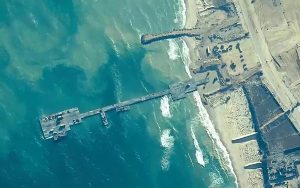
Tiger shark washes up on Nantucket; Atlantic White Shark Conservancy reports new detection data
A large tiger shark washed up on a Nantucket beach this week, a “really unique” incident this early in the season for the warm water species, a leading shark researcher tells the Herald.
The dead shark, estimated to be around 8-feet long, was swept out to sea at Tom Nevers Beach before the apex predator could be secured by beachgoers.
If anyone sees the tiger shark again, researcher John Chisholm wants to know.
“We want to find this shark to do a necropsy and figure out what happened to it,” Chisholm, who’s with the New England Aquarium and confirms shark sightings for the Atlantic White Shark Conservancy, told the Herald.
“Did someone offshore catch it and release it? Did it travel north in a warm water eddy and then succumb to the cold waters?” he asked.
Juvenile tiger sharks have been spotted along Nantucket later in the season in past years, Chisholm said. It’s quite rare to see a larger tiger shark on the island, especially this time of the year, he added.
“This is really, really unique,” Chisholm said. “The bigger ones are usually down off the (Northeast) Canyons where the water is warmer in July and August.”
Recent research has found that tiger sharks are migrating farther north each year because of warmer oceans, he noted.
While waters off the Northeast have historically been too cold for tiger sharks, temps have warmed significantly in recent years and are now suitable for tiger sharks, according to researchers.
“They’re definitely on my radar due to the increasing water temperatures,” Chisholm said.
Related Articles
Orca spotted off Cape Cod. Will killer whales attack local white sharks? ‘Time will tell’
Dead seals with shark bites found along Cape Cod: ‘Be aware of the sharks’ presence in the shallow waters’
Sharks spotted off Cape Cod ahead of Memorial Day weekend: ‘Right on schedule for when they start showing up’
Cape Cod shark researchers get ‘shark’s-eye’ view after putting camera tag on great white
Boston’s Whale Jam concert blends great work, great tunes
An unusual & sad sight on the south shore this week. A tiger shark washed up dead on Tuesday.
It is relatively rare to see a tiger shark in the waters around Nantucket, and especially in spring when water temperatures are still low. pic.twitter.com/WpKNVtOYua
— Nantucket Current (@ACKCurrent) June 7, 2024
Beachgoers at the Nantucket beach tried to bring the tiger shark up on the beach, but the surf washed it back out.
“Try to secure it if you can,” Chisholm said. “Always be careful. I don’t want anyone getting hurt.
“Get it up above the high water line, so it doesn’t wash away,” he added.
Chisholm can be notified via his social media account on X: @MA_Sharks. He also advised people to contact the local harbormaster if they find the shark.
New white shark data
The Atlantic White Shark Conservancy has updated its “White Shark Logbook” with last year’s detection data for white sharks along Massachusetts.
The most white shark detections yet again were recorded on the Atlantic-facing beaches along the Outer Cape.
“Because that’s where most of the seals are located,” said Megan Winton of the Atlantic White Shark Conservancy. “In Cape Cod Bay, the highest detections were off Manomet Point where seals typically hang out.”
Chatham’s Monomoy Island, where there are massive seal populations, had the most detections last year.
Overall, 128 white sharks were detected off the coast last year, which was slightly down from 134 great whites in 2022.
Total detections dropped to 145,260 compared to 194,779 in the previous year.
“Every year is different, and the ocean is a rapidly changing place,” Winton said. “We see fluctuations in shark activity every year.
“It’s important to continue monitoring the population to understand why things vary year to year, and month to month,” she added.
The top month for detections was in October, a change from the previous year when the peak month was August. November was also a strong month for detections last year.
“It could be related to the variation in the water temperature from year to year,” Winton said.
The top detection months last year were October (40,322 detections), August (29,837), September (25,559), November (24,382), and July (17,073).
Acoustic receivers are underwater listening stations that record “pings” from acoustic transmitters that have been deployed on more than 300 white sharks by the state Division of Marine Fisheries since its tagging program began in 2010.
The receiver array is deployed from the late spring into the winter of each year to monitor the occurrence and habitat use of white sharks in Massachusetts state waters.


